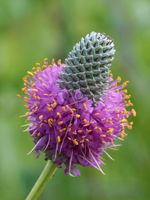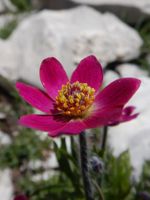Mon-Fri 9am - 5pm Mountain time
Purple Prairie Clover vs Cutleaf Anemone
Dalea purpurea
Anemone multifida
NOT AVAILABLE THIS SEASON - MIGHT RETURN
NOT AVAILABLE THIS SEASON - MIGHT RETURN
Purple Prairie Clover is a native perennial wildflower known for its striking purple blooms. The flower heads grow as dense spikes on tall stems, with each flower head containing many tiny blossoms. Blooming for 4–6 weeks in the summer, it attracts a variety of pollinators, including bees and butterflies.
The high protein content of the Purple Prairie Clover makes it excellent forage for wildlife and birds like to feed on its seeds. As a nitrogen-fixing plant, it enriches the soil, improving fertility and benefiting nearby vegetation. These ecological contributions make it a great choice for pollinator gardens, prairie & rangeland restoration, naturalization, and re-vegetation efforts.
This drought and heat-tolerant plant thrives in various soil conditions, including rocky soil, making it remarkably easy to grow in challenging environments.
Pacific Anemone is a native perennial wildflower with buttercup-like blooms. The flowers can be a variety of colors, including white, pink, and dark red. The deeply cut leaves add a unique texture to the landscape. The flowers bloom from May to August, providing early-season nectar and pollen for insects. They attract a variety of pollinators, including bees and butterflies.
As the flowers fade, they become fluffy white seed heads, which birds often use in their nests. They can spread readily through self-seeding; to limit their spread, regular deadheading is recommended. Tolerant of drought and poor soils, the Pacific Anemone is well suited for wildflower gardens, pollinator gardens, and naturalization projects.

